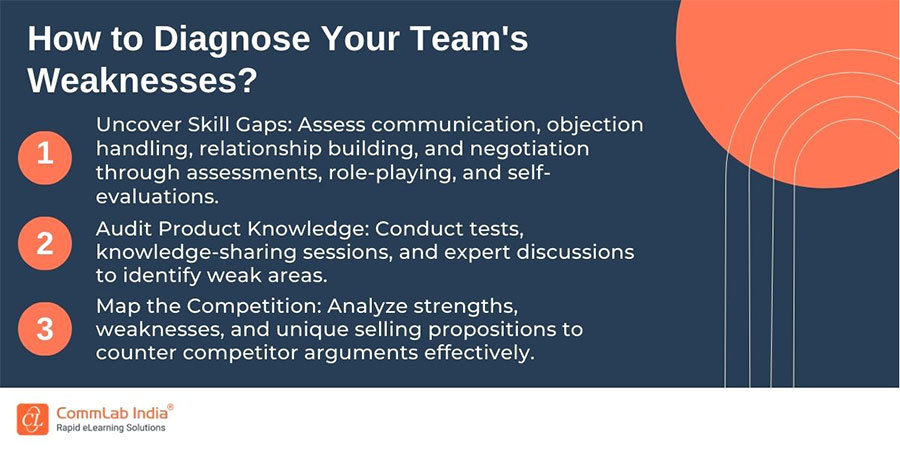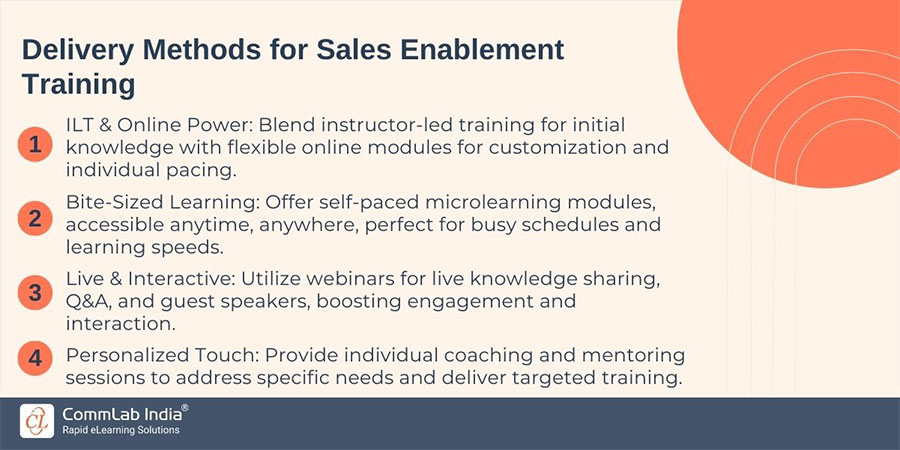How to Boost Sales Enablement Training Success? 7 Surefire Strategies!

In today's competitive landscape, sales teams face immense pressure to navigate complex customer journeys, master intricate product features, and possess exceptional communication and negotiation skills. This is where sales enablement training steps in, acting as a game-changer for organizations seeking to empower their sales force and achieve consistent growth.
But simply throwing together a sales enablement training program isn't enough! To guarantee "sure shot" results, it is very important to have a well-structured and meticulously planned approach. This blog delves into the seven essential strategies that form the bedrock of an effective sales enablement training plan, paving the way for your sales team to excel.
Why Sales Enablement Training?
Because:
- It equips your team with the skills to close more deals.
- It bridges the gap between knowledge and real-world application.
- It empowers your sales force to adapt to a changing market.
- It drives revenue and boosts your business bottom line.
Sales Enablement Training: 7 Strategies to Successes
1. Needs Assessment: Unveiling the Hidden Gaps
Before even thinking about content or delivery methods, it's very important to understand where your sales team stands. Conduct a thorough needs assessment to identify existing skill gaps, knowledge deficiencies, and areas requiring improvement. This involves:

Remember, a data-driven approach is key. Leverage sales performance data, customer feedback, and internal surveys to pinpoint precise areas where training can make the biggest impact. By understanding your team's specific needs, you tailor your training program for maximum effectiveness.
2. Goal Setting: Charting the Course to Success
Once you know where you stand, it's time to chart the course. Define clear, measurable, achievable, relevant, and time-bound (SMART) goals for your training program. These goals should align with your overall business objectives and be specific enough to track progress.
Examples include:
- Increase win rates by 15% within 6 months.
- Reduce average sales cycle time by 10% within a year.
- Improve customer satisfaction scores by 5% by the end of the quarter.
Set Achievable Challenges: Craft SMART goals to motivate your team, guide their progress, and measure training effectiveness.
→ Download Now: Online Learning for Corporate Training [eBook]
3. Content Curation: Beyond Product Knowledge, Towards Holistic Enablement
Forget product overload! Today's sales training needs a makeover. Cater to your team's diverse needs with a blended approach that covers:
- Essential Skills: Master communication, active listening, objection handling, and negotiation through interactive modules, simulations, and role-playing.
- Know Your Customers: Deep dive into your ideal customer profiles, understanding their needs, pain points, and buying behaviors for personalized interactions.
- Outsmart the Competition: Equip your team with competitor insights, strengths, weaknesses, and offerings to effectively position your products and counter arguments.
- Negotiate Like a Pro: Master negotiation strategies and tactics through case studies, simulations, and expert coaching to secure win-win deals.
Engage & Motivate:
- Variety is the Spice: Infuse microlearning, gamification, social learning, and interactive videos for sustained engagement.
By addressing diverse needs, you create a well-rounded training program that empowers your team to conquer every sales frontier.
4. Delivery Methods: Catering to Diverse Learning Styles
Content is key, but delivery makes it stick! Ditch the cookie-cutter approach and cater to diverse learning styles with this mix:

By mixing it up, you create a dynamic learning experience that empowers your team to thrive.
5. Practice & Reinforcement: Embedding Knowledge into Action
Knowledge alone isn't enough. Bridge the gap and empower your team with:
- Realistic Role-Playing: Mirror real interactions, practice skills, get feedback, and refine your approach.
- Immersive Simulations: Apply learnings, make decisions, and experience consequences in simulated sales environments.
- Real-World Case Studies: Analyze challenges, develop critical thinking, and apply techniques through real-world examples.
- On-the-Job Coaching: Get ongoing support, address challenges, celebrate successes, and put new skills into action.
- Beyond the Training: Utilize spaced repetition, microlearning, and knowledge sharing for continuous learning and skill retention.
Ample practice and ongoing support empower your team to confidently apply their learnings in real-world scenarios, turning knowledge into action and achieving success.
6. Measurement & Evaluation: Tracking Progress and Impact
Don't just train, track! Prove ROI with a robust training measurement system, focusing on:
- Knowledge Retention: Measure information retention through quizzes, knowledge checks, and skill demonstrations.
- Skills Improvement: Evaluate progress in communication, objection handling, and negotiation via role-playing, simulations, and manager feedback.
- Sales Performance: Track win rates, average deal size, and sales cycle time to measure real-world impact.
- Goal Achievement: Monitor progress towards SMART goals to ensure desired business outcomes.
Data is your friend! Leverage analytics to identify strengths, weaknesses, and areas for improvement. By continuously measuring and refining, you guarantee your training program delivers consistent results and empowers your sales team to excel.
7. Continuous Improvement: Embracing the Learning Journey
Sales are dynamic, so should your training! Stay ahead with:
- Feedback Loop: Gather insights from trainees, managers, and stakeholders to continuously improve your program.
- Trend Spotting: Track industry trends, best practices, and emerging technologies to keep your training relevant and impactful.
- New Skills Integration: Based on feedback, data, and industry shifts, weave new insights, skills, and techniques into your program.
Remember, sales enablement is a journey, not a destination. By fostering a culture of continuous learning and improvement, you empower your team with the agility and adaptability to conquer any sales landscape.
Know if Your Sales Enablement Training Has These Key Elements [Watch Video]
Conclusion: Empowering Your Sales Team for Success
By incorporating these seven essential elements into your sales enablement training plan, you lay the foundation for a high-performing, well-equipped sales team. Remember, it's not just about imparting knowledge; it's about creating a comprehensive learning experience that empowers your team to excel in every aspect of the sales process. Invest in your sales team's development, and reap the rewards of consistent growth and success.
Want to make your training more impactful? Try online learning. Here's an eBook to guide, download now!



![4 Quick Tips To Make A Successful LMS Switch [Infographic]](https://blog.commlabindia.com/hubfs/Imported_Blog_Media/tips-for-successful-lms-switch-infographic.jpg)

![5 Essential Tools For eLearning Success [Video]](https://blog.commlabindia.com/hubfs/blogs/elearning-essential-tools-video.jpg)